Airports of the Future
What’s next for air-travel design? Buildings that ease passenger aggravation and respond to the local culture and environment.
![]() Continuing Education
Continuing Education
Use the following learning objectives to focus your study while reading this month’s Continuing Education article.
Learning Objectives - After reading this article, you will be able to:
- Describe ways of accommodating rapidly evolving technology in terminal design and avoiding obsolescence.
- Describe how changing security needs and traveler preferences are shaping the form and configuration of airport terminals.
- Describe the climate-control strategy at Jewel Changi and explain how the needs of people and plant life were met.
- Explain how ubiquitous computing can be used inside terminals to enhance passenger flow.
Airports of the Future
What’s next for air-travel design? Buildings that ease passenger aggravation and respond to the local culture and environment.
Terminals Poised for Takeoff
By Joann Gonchar, FAIAView course on architecturalrecord.com »
Except for people who have their own jets, most would agree that the romance of air travel faded long ago. But that isn’t stopping those who want to be on the move. Worldwide, aviation numbers are expected to double to 8.2 billion passengers per year by 2037, say estimates by the International Air Transport Association. Airports everywhere are racing to ramp up capacity, with $737.3 billion-worth of projects in planning, design, or construction globally, according to one industry-analysis firm.
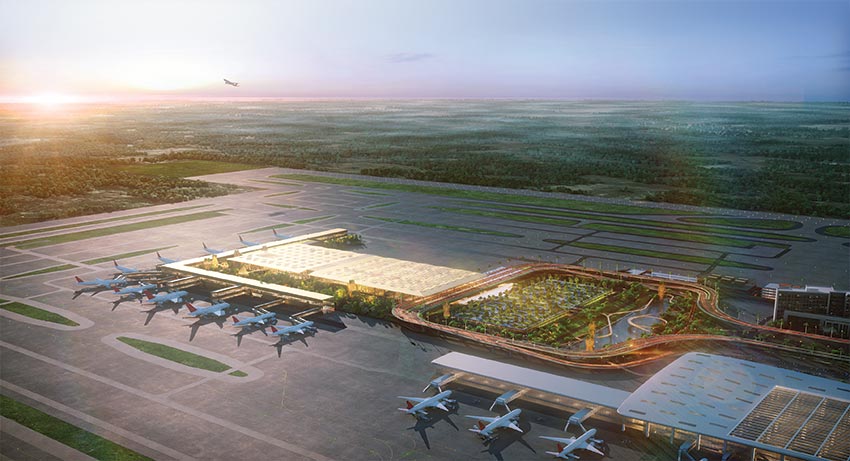
Image: © SOM | Atchain
Kempegowda International Airport Terminal 2, Bengaluru India, SOM
More than many countries, the United States is suffering from outmoded aviation infrastructure, with the average terminal building more than 40 years old. According to T.J. Schulz, president of the Airport Construction Council, at least $70 billion is being spent over five years, beginning in 2017, modernizing 50 medium and large U.S. airports. The lion’s share of this sum is going toward terminals—their revamping, expansion, or construction.
For architects, the focus is not merely on moving travelers from curbside to gate as smoothly as possible but trying to improve the ambience of travel. “It’s not all about speed and efficiency,” says Ryan Fetters, a senior associate in Gensler’s San Francisco office. In a joint venture with Kuth Ranieri Architects, Gensler is part of a design-build team for the landside of the $2.4 billion Harvey Milk Terminal 1 under construction at San Francisco International Airport (SFO). The team describes the facility as transparent and daylight-filled, with features such as intuitive navigation, site-specific art, and generous areas for passengers to reorganize their belongings after going through security.
Many architects are trying to elevate the passenger experience by injecting airports with local flavor. “We try to capture the spirit of the place, even if it isn’t a top goal of the client,” says Laura Ettelman, managing partner in the New York office of SOM. Among her firm’s current projects is the 2.4 million-square-foot Terminal 2 at Kempegowda International Airport in Bengaluru, India, organized around a series of indoor and outdoor green spaces. The scheme, inspired by the tech hub’s history as a garden city, takes advantage of its benign climate and will offer a “rich, sensory experience,” she says.
For architects dealing with a multitude of complex functional requirements and rapidly advancing technology, terminals are buildings that can quickly become outmoded, says Ettelman’s colleague Derek Moore, SOM aviation-practice leader. He points to Eero Saarinen’s TWA Flight Center at New York’s John F. Kennedy International Airport as the “poster child” of this obsolescence problem. Enclosed by a dramatic, winglike thin-shell roof, the building, which was conceived before the introduction of the first commercial jet, was out of date almost as soon as it opened in 1962 (see page 96).
Since TWA, aircraft have of course continued to evolve, though sometimes in unexpected ways. The latest example is the phaseout of the Airbus A380 announced by the manufacturer in February. Sales of the superjumbo jet, designed for long-haul travel and carrying up to 850 passengers, have been stagnant as airlines opted for smaller planes that use less fuel per seat. Many of the budget airlines that serve regional airports, meanwhile, have been flying fewer flights than before, now with larger aircraft, like the Boeing 737 and Airbus A320, for similar reasons of economy.
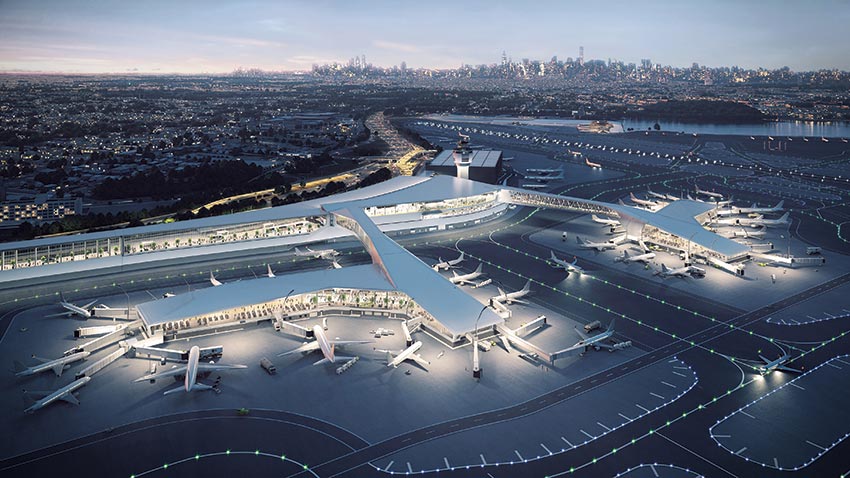
Images: © HOK and WSP;
Terminal B, LaGuardia Airport In New York, HOK and WSP have designed a headhouse connected to a pair of “island” concourses via pedestrian bridges.
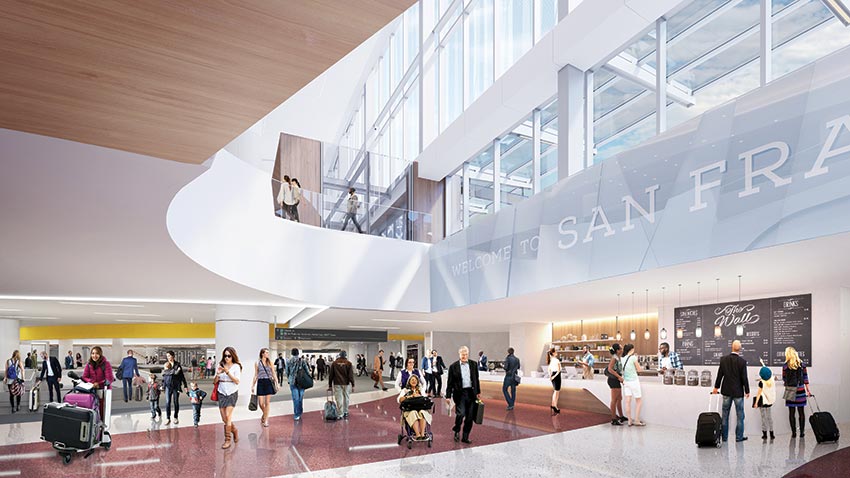
Images: © Gensler/Kuth Ranieri Joint Venture
Harvey Milk Terminal 1, San Francisco International Airport This 25-gate terminal will feature several multistory spaces that allow daylight to penetrate its lowest levels.
Disruption in the airline industry can make a facility outmoded almost overnight. Pittsburgh International Airport occupies a 1992 terminal designed as a US Airways hub to handle up to 32 million passengers per year, many of them connecting to other flights. But after US Airways merged with American in 2013, traffic hit a low, and the airport now operates primarily as an origin and destination facility, with about 9.5 million passengers annually. Officials plan to “right size” by building a smaller terminal, now in schematic design by a joint venture of Gensler and HDR in association with Madrid-based luis vidal + architects. “We currently have ever increasing maintenance costs and aging infrastructure that we can’t upgrade,” explains Paul Hoback, the airport’s chief development officer.
The changes in how people get to the airport are affecting planning as well. More people are arriving by ride-share services like Uber and Lyft, and revenue from parking is falling. Yet, despite this trend, many airports are still building garages, primarily to house their rental-car concessions. One possible future use, should garages no longer be needed, would be as service hubs for automated-vehicle fleets, suggests Chris Donahue, a principal with the Abstract Group. The firm is a consultant to Michael Baker International, the company designing the garage and ground-transportation center at the new Pittsburgh airport.
Inside terminal buildings, the most consequential development is the ratcheting up of security. The screening process has become increasingly invasive and stressful as well as space-hungry, with snaking queues and bulky equipment. But new technologies, such as biometric identification, along with artificial intelligence to help target threats, promise to make security checks faster—less onerous yet more thorough. Facial-recognition systems like the one introduced last December at Delta Airlines at Atlanta’s Hartsfield Jackson International Airport (the world’s busiest, in terms of annual passengers), should also reduce the amount of real estate that screening requires, say proponents.
Other technological trends with operational and space implications include a growing reliance on automation and self-service. For instance, pre-security areas are shrinking now that passengers routinely check in before arriving at the airport or via self-service kiosks, and often tag their own bags. So-called individual carrier systems (ICS) for baggage handling, which rely on RFID chips, offer improved tracking, speed, and energy efficiency, though they do not necessarily save space. At SFO’s Harvey Milk, which will have one of the first installations of an ICS in the country, accommodating the machinery’s height requirements “was a bit of a jigsaw puzzle,” says Richard Spencer, aviation-design director for Woods Bagot. His firm, along with HKS, ED2 International, and KYA, is designing the air side of the terminal as part of a design-build team.
Seasoned airport designers caution that, while these technologies rapidly evolve, “the story of the next 20 years is likely to be automation, biometrics, and AI, but no one really knows,” says Andrew Thomas, a partner at Grimshaw Architects in London. Thomas, who led his firm’s team in designing the recently opened 11 million-square-foot terminal at the Istanbul New Airport—said to be the world’s largest—recommends against designing tightly to current tech requirements. Instead, he advocates for “deep floor plates and a loose fit.”
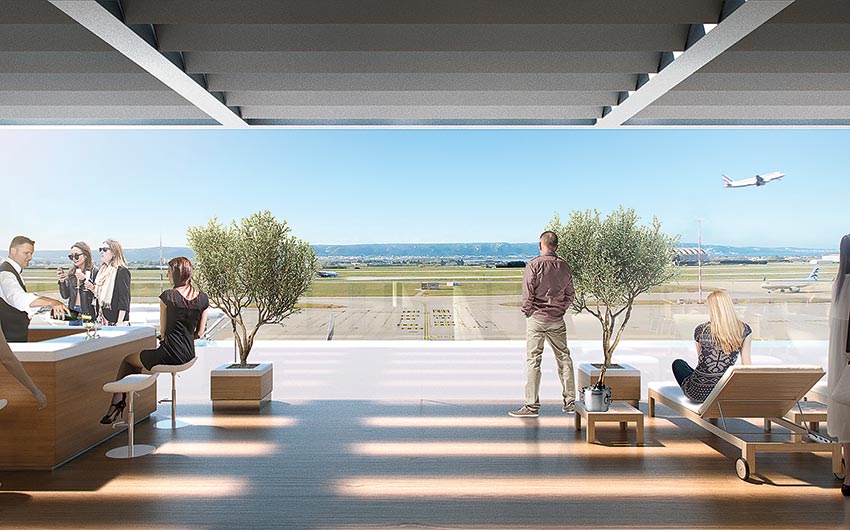
Images: © Foster + Partners
Marseille Airport An expansion for this Mediterranean city, designed by Foster + Partners, will include a terrace overlooking the tarmac and the view beyond.
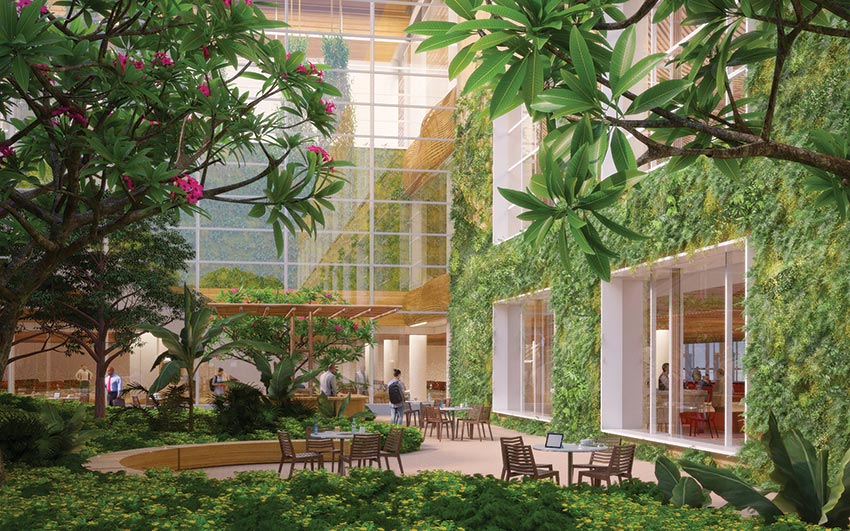
Images: © SOM
Terminal 2, Kempegowda International Airport For Bengaluru, India, SOM has designed a building organized around a series of indoor and outdoor green spaces.

Courtesy Pittsburgh International Airport
Pittsburgh International Airport The subtly undulant roof of the planned new terminal is intended to recall the region’s landscape.
Building in such flexibility undeniably makes sense, especially for a greenfield facility well outside the city center, like the Istanbul airport. But projects at urban airports with little wiggle room are trickier. Some, like the new Terminal B now under way at New York’s LaGuardia Airport (LGA), require an almost surgical approach. In order to keep the maximum number of gates operational during construction, the facility is being built in phases, “alongside, around, and over” the existing 1964 terminal that it is replacing, says Peter Ruggiero, design principal in the Chicago office of HOK. As part of the consortium chosen to design, build, and operate the terminal through 2050, HOK and WSP have developed a scheme that has a headhouse connected to a pair of gate-concourse buildings via pedestrian bridges. These span over the plane taxi lanes. So far, 16 of the planned 35 gates are open, with completion slated for 2022.
Transparency is a common theme at new airports, as architects endeavor to make navigation as straightforward as possible and reduce passenger stress. At LGA’s Terminal B, travelers will always be able to see and anticipate the next step in the process, says Ruggiero. Security will be visible from the curbside, and once customers pass through the screening area, the bridges and concourses will come into view through an expansive window wall. And for orientation at Harvey Milk, designers are relying on strategies such as changes in finishes and manipulation of ceiling planes to provide subtle prompts. They also have created a series of multistory spaces that will allow daylight to penetrate the building’s lower levels and give occupants a sense of their location in relation to the outside world. Of course, many tech-savvy people already rely on their smartphones for wayfinding, in addition to using the devices for real-time info about flight status and the length of security lines. “But we hope that light and form will provide the necessary cues,” says Spencer from Woods Bagot. Ruggiero points out that gate areas in aviation lingo are often referred to as “hold rooms,” which implies incarceration. But he and other architects say that the current thinking is to make these spaces into hospitality environments, with varied seating options, plentiful charging stations, better lighting, and improved indoor air quality. And, of course, the gate areas are readily accessible to retail and food concessions, often highlighting local specialties. Passengers waiting for flights can take advantage, too, of a widening array of amenities such as yoga rooms, children’s play areas, or nap pods. Moshe Safdie’s Jewel at Changi Airport in Singapore (page 74) even includes a movie theater.
Arguably, the most surprising amenities cropping up at airports large and small are biophilic elements, both open-air spaces and those that are climate-controlled. SOM’s Kempegowda project is just one example. There is also the lush valley that is the centerpiece of Jewel; a terrace that will overlook the tarmac and the landscape beyond in Foster + Partners’ planned expansion to Marseille Airport; and the garden framed by the revamped Elmira Corning Regional Airport (see page 88), by Fennick McCredie Architecture. All provide an opportunity for passengers to reconnect with the natural world before or after spending hours in a hermetically sealed jet.
The truism that the only constant is change seems particularly apt for airports. Let’s hope that the trend toward air terminals with immersive green, soothing environments turns out to be one that endures.
Jewel Changi Airport | Singapore | Safdie Architects
Green Machine
Designers reinvent the airport experience with deft engineering, unusual geometry, and a vast indoor garden.
By Joann Gonchar, FAIA
Say the word “airport” and even the most intrepid road warriors are likely to think of the headaches associated with air travel, such as lost luggage, delayed flights, intrusive security screenings, and long lines at international entry points. Travelers are probably not envisioning a verdant landscape with cascading water features or meandering walking trails. But that is what people encounter inside Jewel at Singapore’s Changi Airport. The $1.2 billion structure, designed by Cambridge, Massachusetts-based Safdie Architects, weaves retail space, food outlets, and passenger conveniences together with a flourishing green space of palm and bamboo trees, canyons, and a 130-foot-tall waterfall—all within an immense, climate-controlled toroidal glass enclosure.
The 1.7 million-square-foot Jewel, which sits on the site of a former surface parking lot and connects to three of the airport’s four terminals, is the outcome of a competition that Safdie entered with developer CapitaLand. It is part of a set of long-range projects that aim to increase the airport’s capacity from 65 million to 135 million passengers by 2030, including a third runway and a terminal designed by Heatherwick Studio, KPF, and Architects 61. The aspiration for Jewel was not only to entice more people to travel through Changi, but also build upon its curious popularity among Singaporeans as a destination in its own right—a place readily accessible to the rest of the island via mass transit, where the nontraveling public can shop, eat, and spend leisure time. Toward those goals, the 2014 request for proposals called for a shopping mall, airport services that included early check-in facilities and baggage storage, plus an unspecified “attraction.”
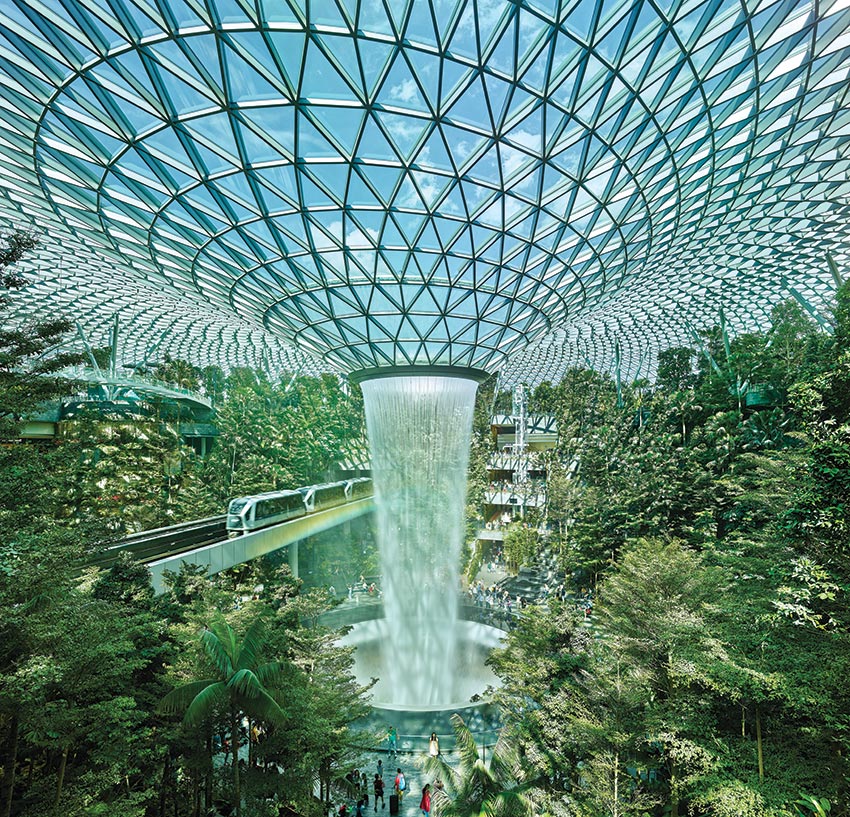
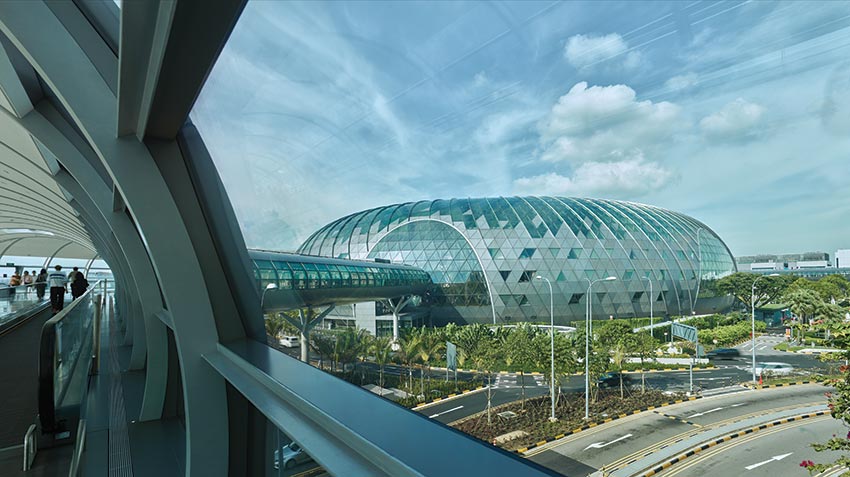
Photography by Tim Hursley
CRYSTAL PALACE The centerpiece of Jewel’s toroidal glass-and-steel dome is a funnel-shaped oculus from which a “rain vortex” flows at up to 10,000 gallons per minute (opposite). Tubular pedestrian bridges (above) connect the building to two of Changi’s terminals.
To fulfill this open-ended part of the brief, Moshe Safdie, the architecture firm’s founder, proposed a “mythical garden” as the focal point around which Jewel’s other programmatic elements could be organized and as a fitting gateway to the famously lush city-state. Dubbed the “forest valley,” the resulting green space takes the form of an 80-foot-tall stepped elliptical void that is topped with a “canopy park” with follies such as a topiary walk, a mirrored maze, and a glass-bottomed bridge. Encircling the valley on four levels above grade and two below (with 2,500 subterranean parking spaces below that), are a shopping mall, a movie theater, a hotel, and other traveler conveniences. These amenities are kept separate from the green space, but the designers sliced slot-like “canyons” through the valley bowl, providing visual connections between the two distinct environments. Conscious of the disorienting potential of buildings with round footprints, the architects have also arranged the cuts to provide views to the outside, including one aligned with the air traffic control tower.
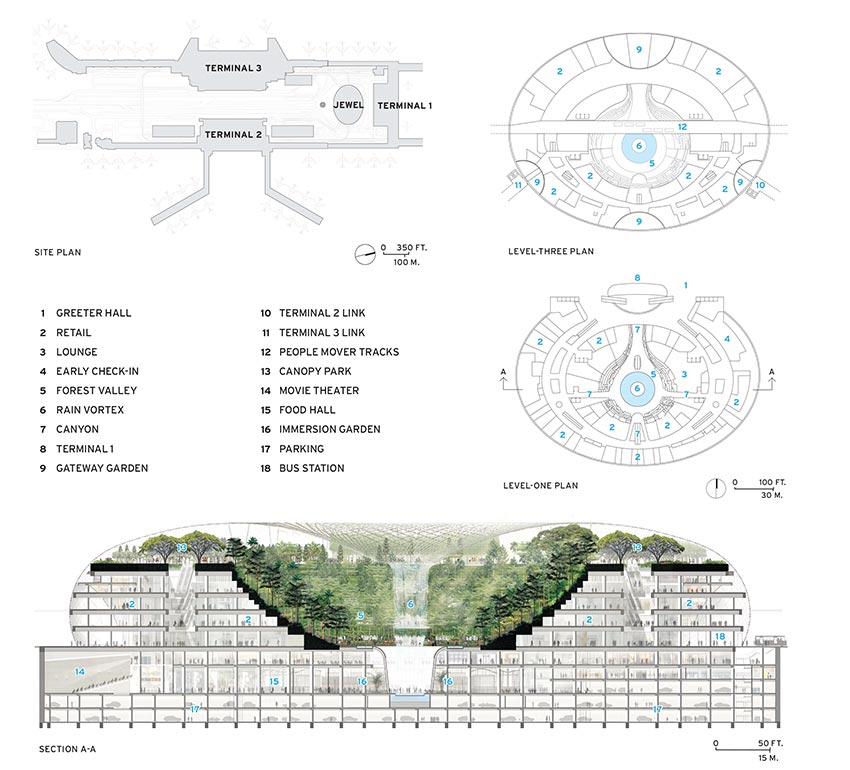
The valley and the spaces around it have a mostly conventional concrete-and-steel structure. But the toroid, a glass-and-steel grid shell 675 feet across at its widest point, is highly sophisticated, and largely self-supporting, except for 14 treelike columns. The shell consists of hollow-section steel beams, 4 inches wide and of varying depths, connected by precision steel nodes. The grid shell launches from a ring beam that encircles Jewel at its fifth level and marks a transition in the cladding, with mostly aluminum panels below it and glass above. The roof system spans to the funnel-shaped oculus, from which the veil of water called the “rain vortex” falls.
The vortex, designed by the water feature specialists WET, drops up to 10,000 gallons per minute down seven stories and is Jewel’s most popular selfie spot. However, it is not at the physical center. The waterfall has been positioned slightly to the south to avoid dousing a pre-existing tram that transports passengers between terminals and now traverses Jewel’s valley every few minutes. That placement of the vortex resulted in a subtly irregular doughnut shape for the toroid and meant that no two of the shell’s more than 9,000 double-glazed, triangular panels are alike. This added complexity, of course, but digital design and fabrication methods helped manage the variation, says Craig Schwitter, a partner in the New York office of BuroHappold Engineering, Jewel’s structural and facade consultant. Jaron Lubin, a Safdie Architects principal, points to the parametric model that provides a “recipe” for determining the number, shape, and size of glazing units. It helped designers and the glazing subcontractor “prune” or manipulate the radial geometry, so that none of the panels is too large at the perimeter or too small near the center, he explains.
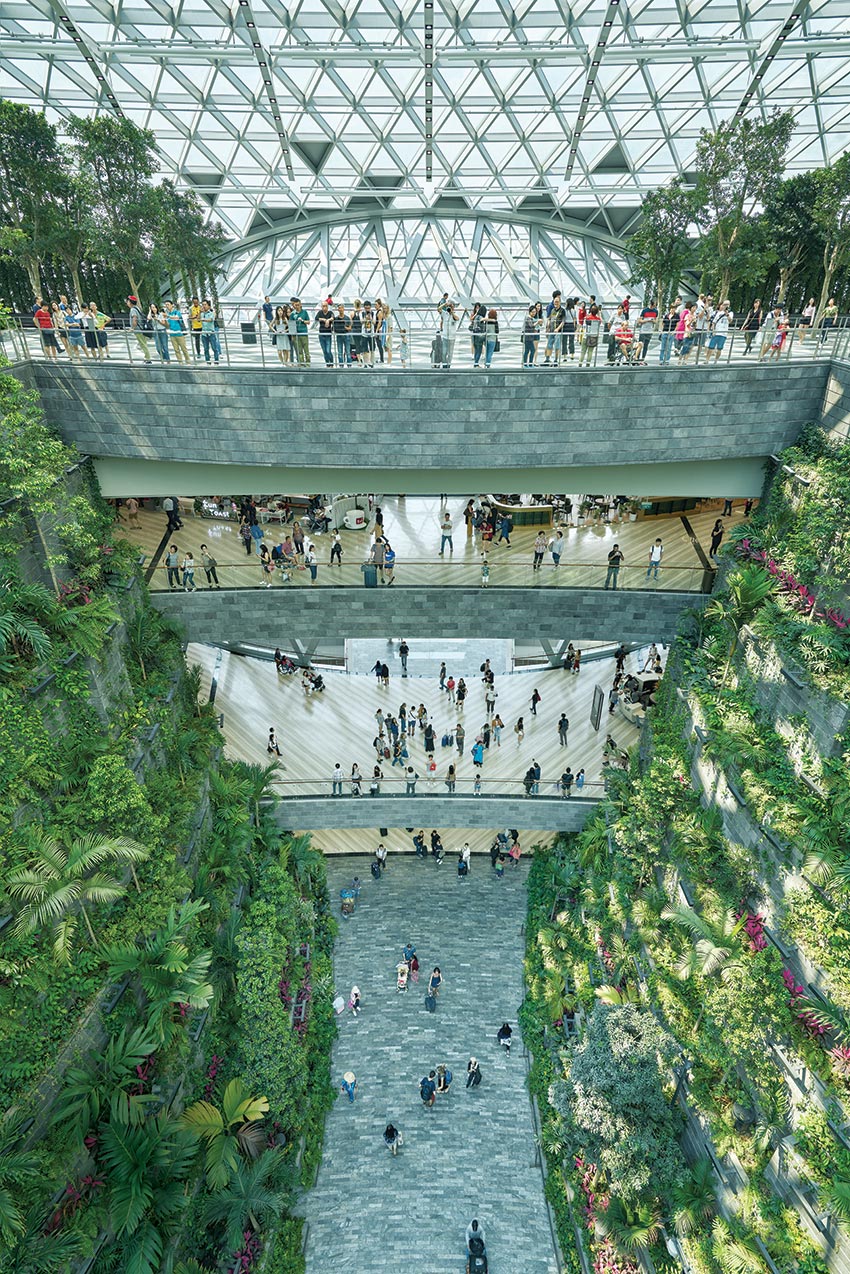
Photography by Tim Hursley
VIEW SHED Slot-like slices through Jewel’s “valley” allow views to neighboring spaces and the exterior, helping prevent visitors from becoming disoriented by the circular form.
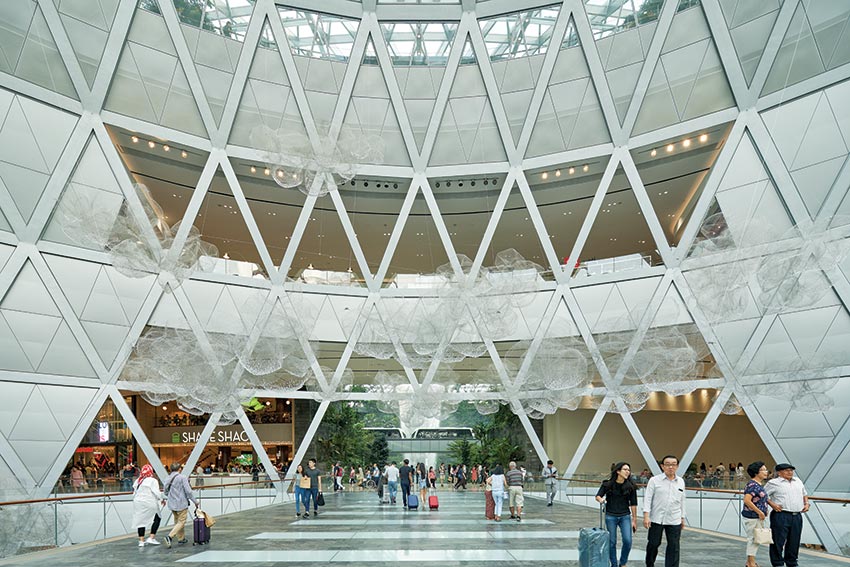
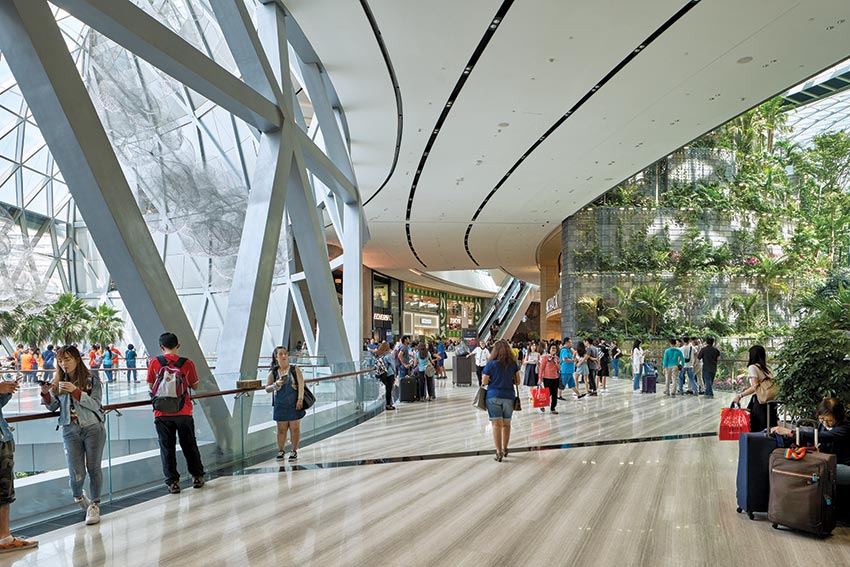
Photography by Tim Hursley
RETAIL WRAP A shopping mall (right) encircles the valley on four levels above grade and two below. As visitors approach Jewel from Changi’s Terminal 1, to which it is directly connected, the vendors and the central green space beyond come into view (above).
To maintain comfortable conditions for both people and plants under the enormous glass bubble, and ensure the building would not be an energy hog, the team enlisted the help of Atelier Ten. The environmental consultant developed the central green space’s climate-control strategy, studying such aspects as heat gain on the envelope, which could be mitigated by coatings and the density of frit patterns on the glazing; and the impact of the rain vortex, so that it would create a pleasant cooling effect rather than big wind gusts. “We wanted some air movement, but not too much,” explains Meredith Davey, an Atelier Ten director in London. “Jewel is all about balance,” he says. Thus, the mechanical system relies on displacement ventilation, supplying fresh air at a low velocity from floor-level vents (many cleverly concealed in architectural elements, including seating), so that only the occupied portions of the vast volume are conditioned. The system is one of many features that helped Jewel earn Gold Plus, the second-highest certification level under Singapore’s GreenMark building-rating program.
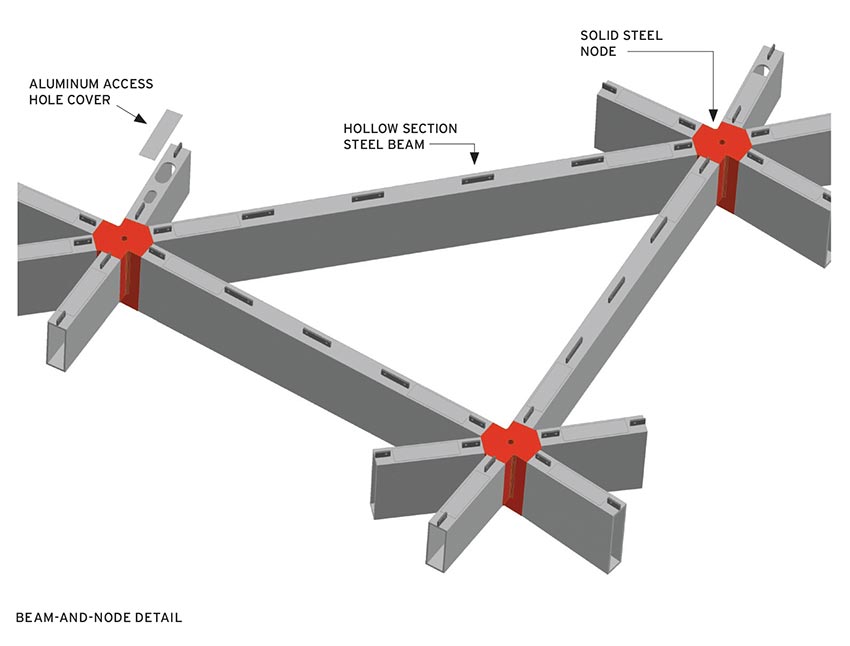
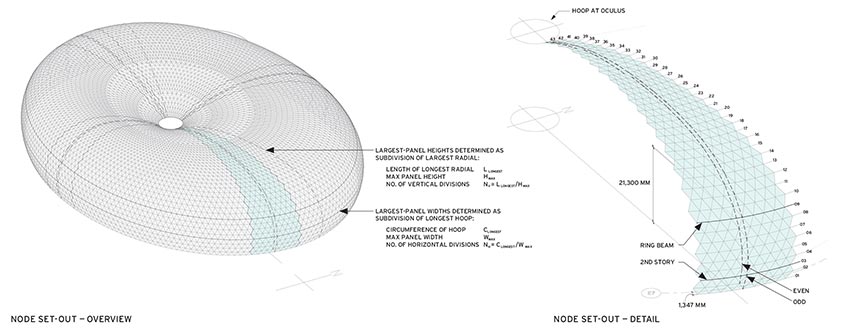
Baking Instructions
The doughnut-shaped grid shell consists of hollow-section steel beams connected by precision steel nodes (top). Designers compare the parametric model of the domed enclosure (above) to a “recipe” for determining the size, shape, and number of its triangular glazing units.
Since the client deemed that 75 degrees Fahrenheit and 60 percent humidity were the optimum conditions for people—considerably cooler and dryer than Singapore’s climate—Berkeley, California–based PWP Landscape Architecture selected Jewel’s trees, shrubs, and other flora from subtropical zones throughout the world. Many of the plants were tested within a “coolhouse” that matched design conditions as closely as possible and, once procured, acclimated in nurseries in Singapore for up to two years before being placed within Jewel’s irrigated trenches, according to Adam Greenspan, a PWP design partner.
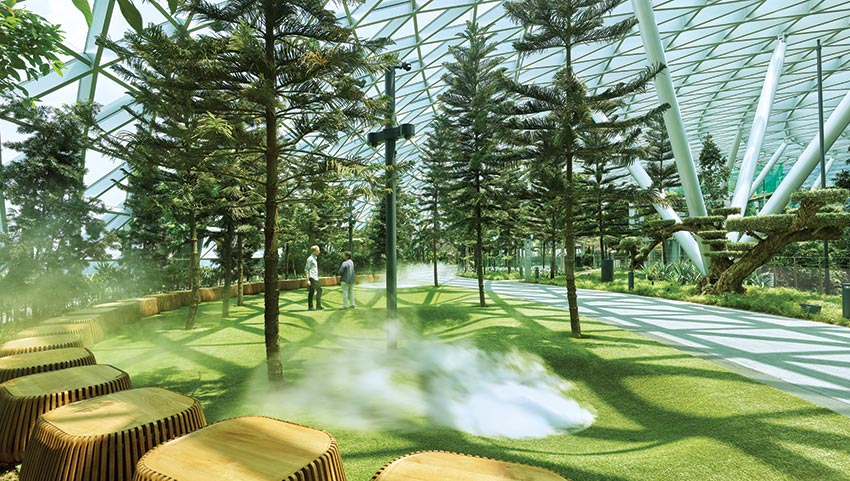
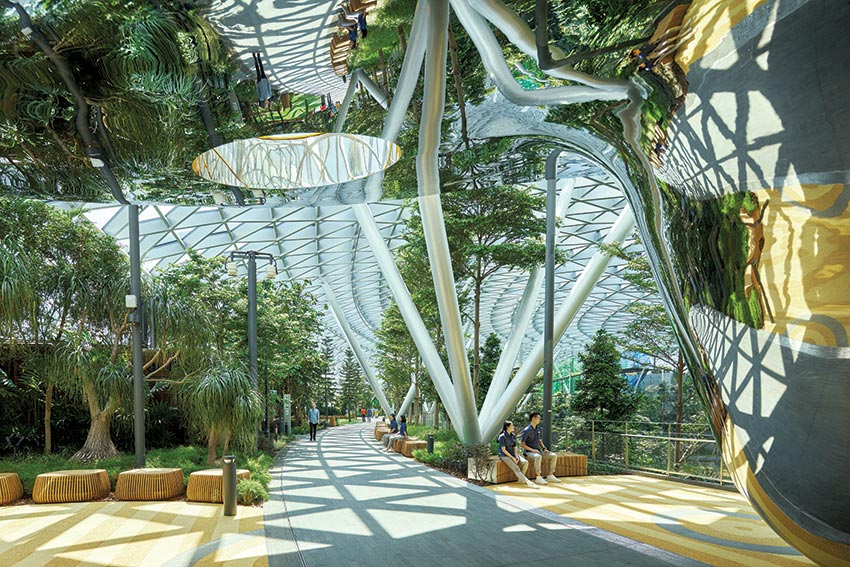
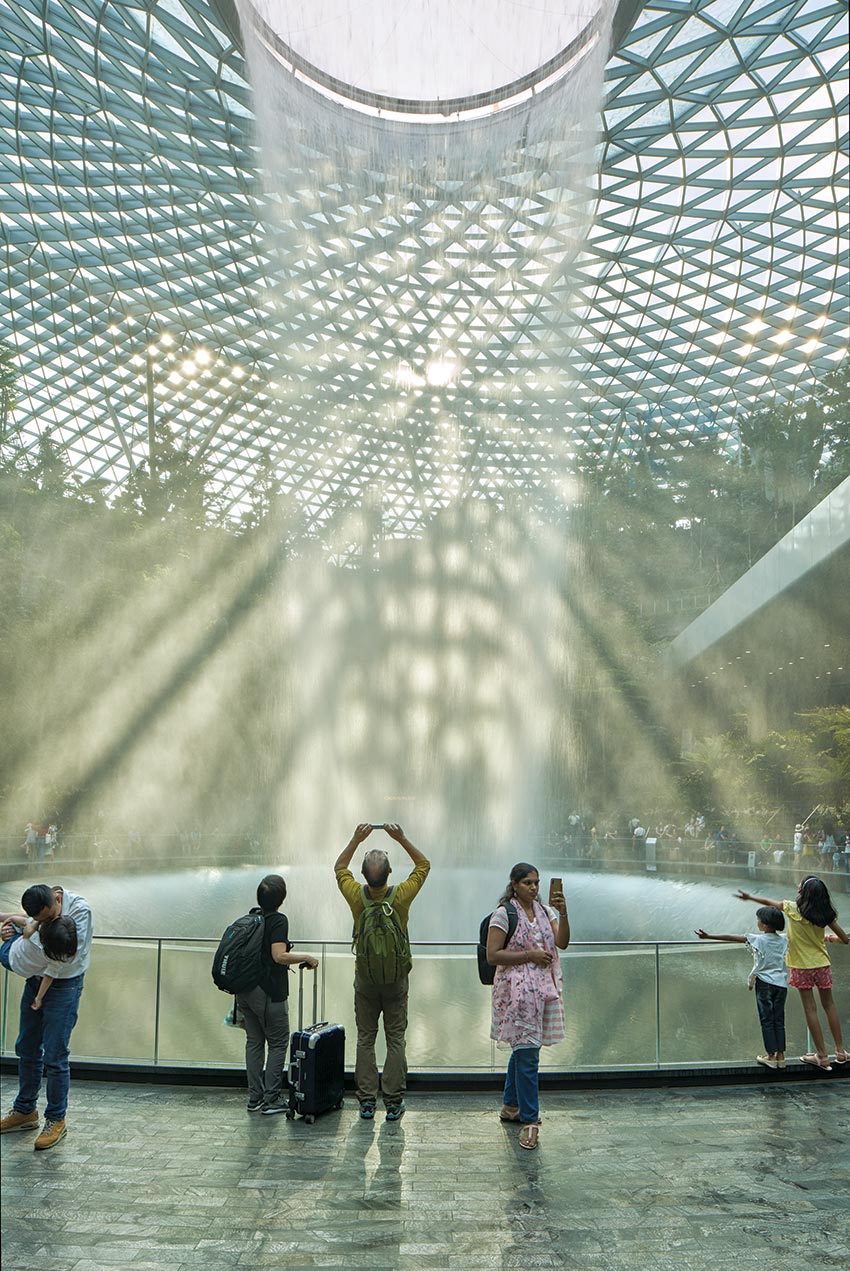
Photography by Tim Hursley
SELFIE MAGNET In addition to the Instagrammable rain vortex (opposite), Jewel contains several other folly-like attractions, including a set of foggy bowls (top) and a series of sculptural, mirrored slides (above).
The landscape approach has proved so successful, says Lubin, that there are spots within Jewel where you are completely shrouded in greenery. Visitors won’t think they are in an actual forest, he admits. But they can forget that they are at the airport—at least momentarily.
Credits
Architect: Safdie Architects — Moshe Safdie, lead designer; Jaron Lubin, Charu Kokate, Greg Reaves, principals; David Foxe, Seunghyun Kim, Benjy Lee, Dan Lee, Peter Morgan, Reihaneh Ramezany, Laura Rushfeldt, Isaac Safdie, Damon Sidel, Temple Simpson, Lee Hua Tan, Andrew Tulen, project teamArchitect of Record: XRSP Architects Planners & Engineers
Consultants: BuroHappold Engineering (roof structure and facades); Mott MacDonald Singapore (m/e/p); Ignesis Consultants (fire); Arup Singapore (acoustics); Atelier Ten (environmental); WET Design (water feature); PWP Landscape Architecture, ICN International Singapore (landscape); Benoy (retail); Lighting Planners Associates (lighting)
General Contractor: Woh Hup
Owner: Changi Airport Group
Size: 1.7 million square feet
Cost: $1.2 billion
Completion date: April 2019 (Phase I)
Sources
Facade: Mero Asia Pacific, Choon Hin Stainless Steel, Yongnam Holdings, Alucobond, Vitro Architectural Glass, CSG Holding, Colt LouvresDoors and Hardware: Tacam Steel, Flamelite, Dormakaba, Won-Door, CLF Shutters, Briton, Elmes
Conveyance: Schindler Group
Beijing Daxing International Airport | China | Zaha Hadid Architects
Cleared for Landing
Once completed, an otherworldly new terminal will alleviate pressure on the capital city’s existing airport.
By Alex Klimoski
A little over a decade after Beijing Capital Airport constructed a new terminal by Foster + Partners to accommodate an additional 50 million passengers a year, the capital city is unveiling a new airport just 30 miles to the south. The 7.5 million-square-foot Beijing Daxing International Airport, designed by Zaha Hadid Architects (ZHA), will include four runways (compared to three at the Capital) and serve 45 million passengers yearly when it opens this fall; by 2025, that capacity is expected to reach an annual 72 million. Built on a greenfield site in a rural area in Hebei province, the starfish-shaped terminal, with its glowing standing-seam aluminum roof and cluster of bulbous skylights, appears as an alien spacecraft—or, for some Chinese, as the auspicious mythological phoenix—when viewed from above.

Photography: © Xinhua/Alamy Stock Photo
STARSHIP Located in a rural area 30 miles south of Beijing, the terminal has a compact form that minimizes distances between gates.
The new airport is a driving force of an economic-development plan to integrate Beijing with the surrounding regions of Hebei and Tianjin, creating a megalopolis that will alleviate congestion and pollution in the capital. Daxing is seen as a crucial multimodal transportation hub, eventually connecting a network of high-speed rail and improved intercity railways and hundreds of upgraded expressways throughout the three regions, which already have 130 million people.



Images: © courtesy Zaha Hadid Architects (top); Xinhua/Alamy Stock Photo (opposite)
THE CENTER HOLDS Steel megacolumns surround a central courtyard, where domestic retail and amenities are located. A mezzanine guides international travelers to passport control. A rendering (opposite) shows how the multilayered core enables visual connections to other levels.
The steel structure has a highly efficient six-pier radial form that minimizes distances between check-ins and gates. By vertically stacking the international and domestic levels around a central multilevel retail atrium, the layout facilitates direct routes for passengers, especially for those with connecting flights (all 150 aircraft bays are no farther than a third of a mile from the central area). “With the star-shaped form, and moving walkways along each spoke, we can achieve minimum connection times,” says Cristiano Ceccato, who leads ZHA’s aviation projects. “If I only have 30 minutes to get on my connecting flight, I know I can make it, because the airport supports me in that way.”
Critical to the terminal’s design was to foster smart technology for ubiquitous function. Catering to China’s highly tech-savvy population, Daxing will feature a completely automated departures mezzanine dedicated to high-frequency domestic travelers, with self-check-in and self-tagging baggage systems that will move passengers expeditiously to security using only their smartphones. “A lot of airports have separate VIP fast tracks, but those amount to small areas within the departure level. This is different,” says Ceccato. “The Chinese have a completely new level of confidence in this technological revolution and have literally poured it into concrete as a separate floor.” At the airport’s north pier, departing passengers can enter the express mezzanine, or go through the full-service check-in at the level above, where international travelers pass along a bridge across the core that also leads to immigration; domestic travelers are led down to the retail floor to get to the air side. Throughout the interior, fluid, sweeping forms are meant to evoke rolling landscapes or lines of calligraphy.
The terminal’s highly flexible design is made possible by eight graceful parabolic megacolumns that curve down from the vaulted-dome ceiling to the ground, supporting the central atrium and the long-spanned roof, and allowing for a vast, open floor plate. These curved structural masts, each topped by a convex 350-foot-diameter skylight, funnel natural light into different areas of the terminal, where retail pods throughout the international and domestic shopping levels can be easily reconfigured. “Over time, shopping requirements and behaviors will change, and, when they do, you will never actually need to rip out the guts,” says Ceccato. “The columns will be unaffected by this.”
Daxing is an exemplar of how airports are evolving into more complex nodes of interconnectivity—of people, machines, information, transportation, and cities. The project has already catalyzed nearby urban development; as Ceccato suggests, people could take the soon-to-be-completed high-speed rail to Daxing and then the bus to work nearby without ever setting foot in the terminal.


Photography: © Xinhua/Alamy Stock Photo (this page and opposite)
SUPPORT GROUP A cluster of curved steel columns underpins the long-spanned aluminum-clad roof. Skylights atop each pillar flood the interior with natural light.
The airport is expected to open in late September, and work on the next phase—an annex to include an additional runway (not designed by ZHA)—has already begun. By 2040, Daxing is expected to serve more than 100 million passengers a year, approaching the traffic volumes of Hartsfield-Jackson Atlanta International Airport, which was ranked the busiest in the world for the 21st year in a row. With the Beijing Capital airport at number two behind Atlanta, the opening of Daxing will make China the busiest aviation market in the world by 2022. “The sheer number of people that the airport will support is staggering,” says Ceccato. “This will not just be a gateway for Beijing—it really will become a gateway to the country.”
Credits
Architect: Zaha Hadid Architects — Zaha Hadid, Patrik Schumacher, lead designers; Cristiano Ceccato, Charles Walker, project directors; Shao-wei Huang, Lydia Kim, project architects; Paulo Flores, project designerASSOCIATE ARCHITECTS: Aéroports de Paris Ingénierie (ADPi)
Engineers: BuroHappold (superstructure, m/e/p); Mott Macdonald (substructure)
Consultants: Pascall + Watson (aviation planners); Arcadis (commercial planners); LogPlan (aviation systems)
General Contractor: Beijing Urban Construction Group
Client: Beijing New Airport Command Headquarters/Beijing Capital International Airport
Size: 7.5 million square feet
Completion date: September 2019
Elmira Corning Regional Airport | Horseheads, New York, Fennick McCredie Architecture
Stress Test
A small terminal’s garden helps counter travel anxiety.
By James S. Russell, FAIA
Though lofty, daylight-splashed ticketing halls are common in airport architecture, Deborah Fennick and her partner Jonathan McCredie took a different approach in the redesign of the four-gate Elmira Corning Regional Airport in upstate New York. They focused instead on the most anxiety-provoking aspect of flying: the security-screening checkpoint, often buried in the terminal if not an afterthought altogether.


Photography by William Horne
TOP FLIGHT To bring tranquility to the airport experience, the team imagined a lush garden (left) that separates the landside ticketing and baggage pavilion (above) from the new air-side concourse behind it.
The $61.5 million expansion was driven primarily to accommodate larger aircraft—and the traffic they generate—used by ultra-low-fare carriers that are growing in non-metropolitan markets. Central to the stress-relieving approach taken by Boston-based Fennick McCredie Architecture is an outdoor green space that separates the steel-framed landside ticketing and baggage pavilion—which they gut-renovated—from the larger, new replacement air-side concourse. The 18,700-square-foot garden, designed by landscape architects Hargreaves Associates, should quickly grow into a tiny forest.
A wall of glass beyond the ticketing area draws the eye to this outdoor space, and a rounded corner signals the presence of a gently sloped, glass-walled ramp that curves its way through the garden, accommodating queueing for security as well as the checkpoint itself.
This “walk through the woods,” as McCredie put it on a recent visit, is a vast improvement over the usual grim march back and forth through a maze of switchbacking tensile barriers—a screening prelude that seems designed to amplify stress over whether the agent will insist on a body search, the baby will start to scream, or the plane will be missed. Travelers can also access the outdoor area—to hang out at café tables or take a stroll. One side of the garden is reserved for people who have not been screened; separated by the glass-walled ramp, the other side is open only to those who have passed through security.

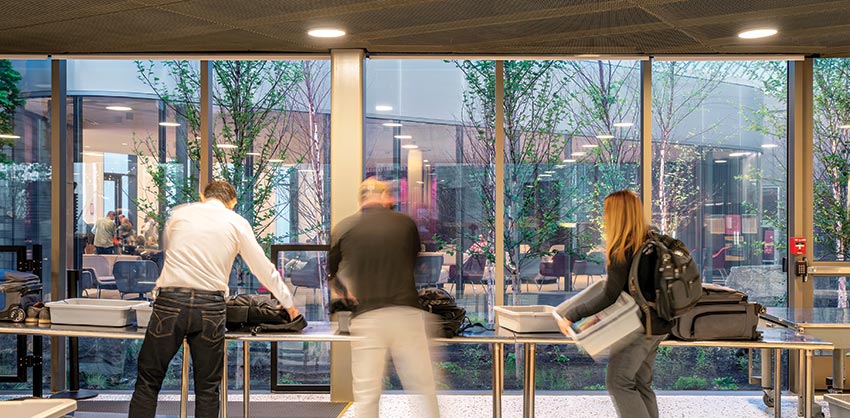
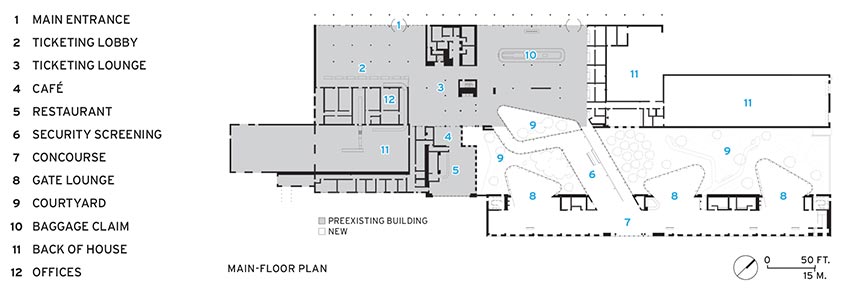
Photography by William Horne
UP AND AWAY Travelers use a glass-walled ramp that curves through the garden (above) and proceeds to the security checkpoint (left).
Along the air-side gate concourse, curved glass walls round the corners of biomorphic lounges that project into the garden. In contrast to the usual rigid rows of departure seating, casually arranged couches and movable chairs invite passengers to relax. Gates are visible from these lounges, further allaying anxiety about missing planes. There are gate-side seats as well, but the view across the airfield is impeded by jetways and other servicing paraphernalia because, as is typical of small airports, the building is a single level and sits low to the ground.


Photography by William Horne
TIGHT CONNECTION The garden provides places to relax before boarding (right). Gates are visible from the lounges, allaying anxiety about missing planes (bottom).
Even with staged construction, to keep the airport open, the project was completed just 26 months from the time Fennick McCredie was awarded the design in September 2016. Both McCredie and the New York State Department of Transportation (DOT) credit Governor Andrew Cuomo, who has made speeding major capital projects to completion a priority (including the multibillion-dollar reconstruction of New York’s LaGuardia Airport, which also is moving quickly). “The governor’s office strove to expedite every aspect of the project,” says Walid Albert, DOT’s chief engineer. “We completed reviews quickly. We didn’t let anything sit in an in-basket if someone was not around.” Adds McCredie, “The governor’s office was very hands-on, down to the paint colors. They did not second-guess or go back to first principles, which was really helpful for the execution. No one slept much.”
Anyone can appreciate Fennick McCredie’s close attention to the experience of moving from curb to plane, given the prevailing view that cargo is often treated better than passengers in today’s swarming airports and on cramped planes. McCredie, whose 50-person office specializes in aviation projects, says security enhancements since 9/11 have taken airport architecture from being “a celebration of flight to focusing entirely on the efficient processing of passengers.” It is the firm’s goal to reverse this trend through a focus on alleviating the stresses endemic to air travel today.

Photography by William Horne
RIGHT AT HOME In place of the usual fixed seating, upholstered furnishings lend lounges a calming, domestic feel.
It’s especially important to bring a measure of calm and dignity to smaller markets, he says, because many customers—especially families and seniors—who don’t fly much, are intimidated by airports. These travelers also tend to be price sensitive, which has brought ultra-low-fare airlines to places like Elmira Corning. Because these companies can afford to serve these locations only if they use bigger, fuel-efficient planes like the Boeing 737 and Airbus A320, the airport had to grow from 55,000 square feet to 88,000 in part to accommodate them. Traffic boomed to 278,000 passengers in 2018, an 11 percent increase in one year. Modest additional growth is expected, but the greater impact on the facility design was allowing for the big-plane peaks, which drove the addition of jet bridges and the enlargement of the departure lounges and screening area.
Airports the size of Elmira Corning never used to see planes with more than 60 seats. Responding to the new economics of aviation as well as security requirements is key to successful design. “These are among the biggest changes in airline travel,” says McCredie. “Small airports have to catch up.”
James S. Russell, FAIA, was a longtime editor at architectural record. He wrote The Agile City: Building Well-Being and Wealth in an Era of Climate Change.
Credits
Architect: Fennick McCredie Architecture — Jonathan McCredie, Deborah Fennick, principals; Aleks Berger, Matt Bermon, Scott Brodsky, Kimberly Cullen, Blake Coren, Meaghan Earner, Nancy Felts, Agnes Jacob, Tim Nolan, Eric Pereira, Sharon Reynolds, Penn Ruderman, teamConsultants: McFarland Johnson (civil, structural, m/e/p/fp); Hargreaves Jones Landscape Architecture
Client: Elmira Corning Regional Airport
Owner: Chemung County, NY
Size: 89,150 gross square feet
Project Cost: $61.5 million
Completion date: October 2018
Sources
Rainscreen: Knight Wall SystemsCurtain Wall: Kawneer
Coiling Drapery: Cascade Architectural Fabricoil
Glass Entrances: C.R. Laurence
Glazing: Guardian, Viracon, Wasco
Resilient Flooring: Armstrong
Furnishings: Herman Miller, OFS, Geiger, Keilhauer
On the Horizon
Six up-and-coming aviation projects, in various stages of planning and construction, will soon be ready for takeoff.
By Kara Mavros
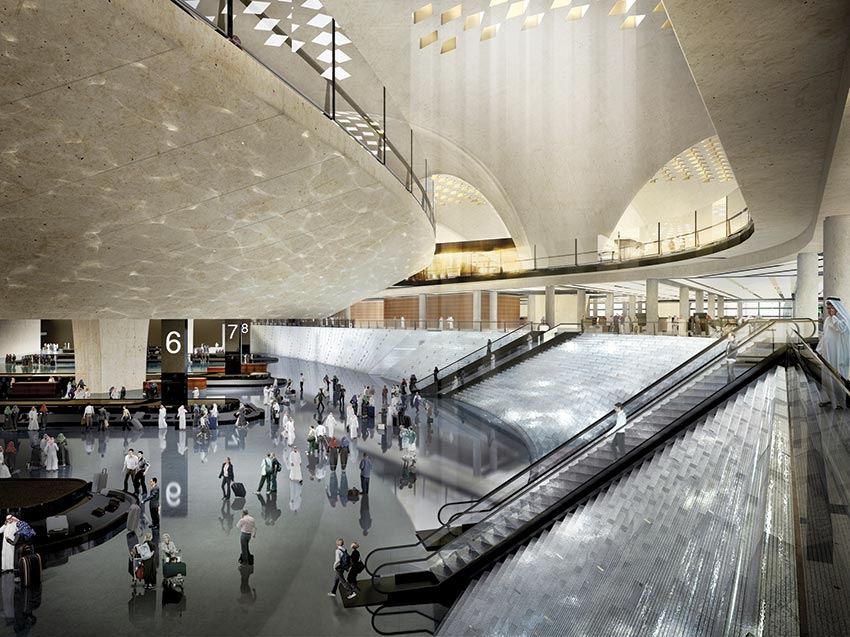
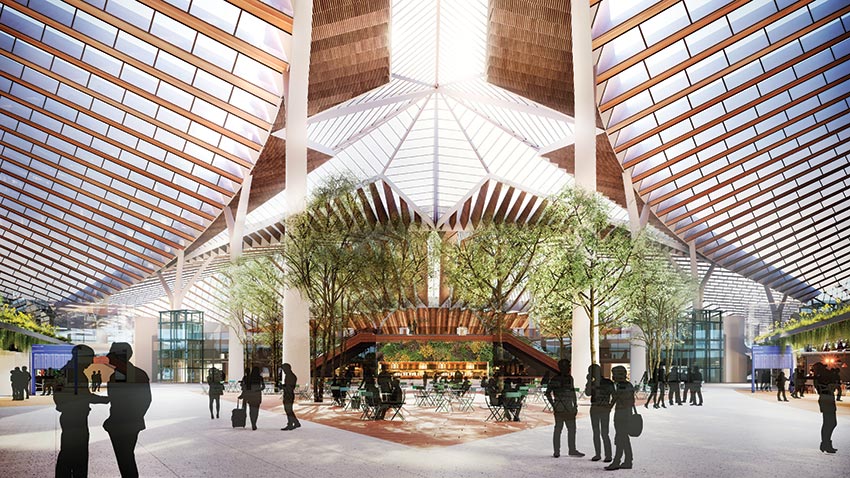
Images: courtesy Foster + Partners (Top); studio ord (bottom)
Kuwait International Airport
The new Kuwait International Airport by Foster + Partners, scheduled to open in 2023, is trefoil-shaped in plan, with all the facilities united under a single concrete-shell roof. The interior receives daylight through large glazed openings in the vaulted structure, as shown in the baggage-claim area (left), which is surrounded by cascading fountains, similar in design to Foster’s “water wall” in the Hearst Tower lobby in New York. Tapering concrete columns support the roof structure, which also carries photovoltaic panels and will help the airport earn LEED Gold certification. About 13 million passengers a year are expected to use the 1.5 million-square-foot complex.
Global Terminal and Concourse at O’Hare International Airport
A new Y-shaped terminal and concourse at Chicago’s O’Hare is being designed by Studio ORD–a partnership among Studio Gang; Solomon Cordwell Buenz; Corgan; Milhouse Engineering and Construction; and STL Architects. The 2.2 million-square-foot facility will be the largest expansion in the airport’s history. The three branches of the terminal meet at a central hub, dramatized by a six-pointed glass skylight (right). Wood ribs and cladding in the ceiling will add a natural warmth to the new building, which is expected to break ground in 2023.

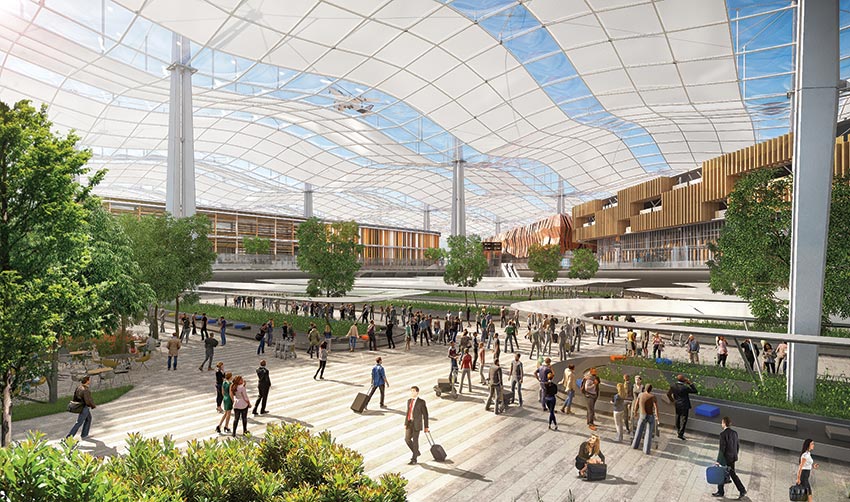

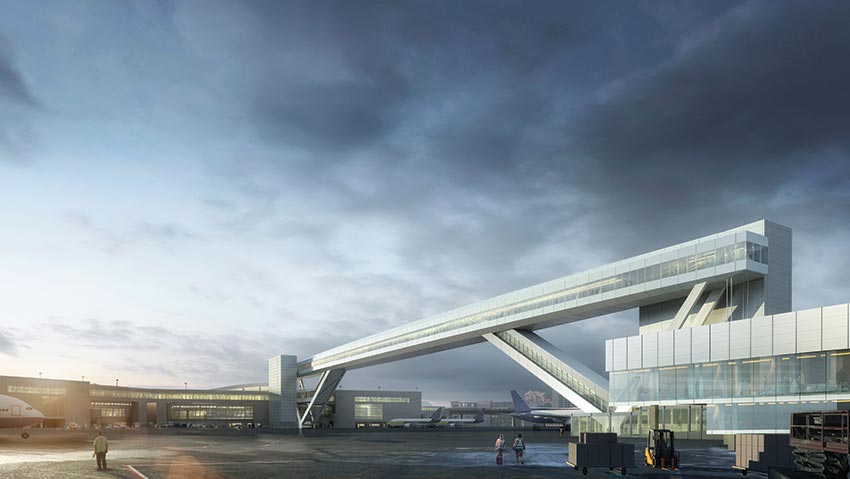
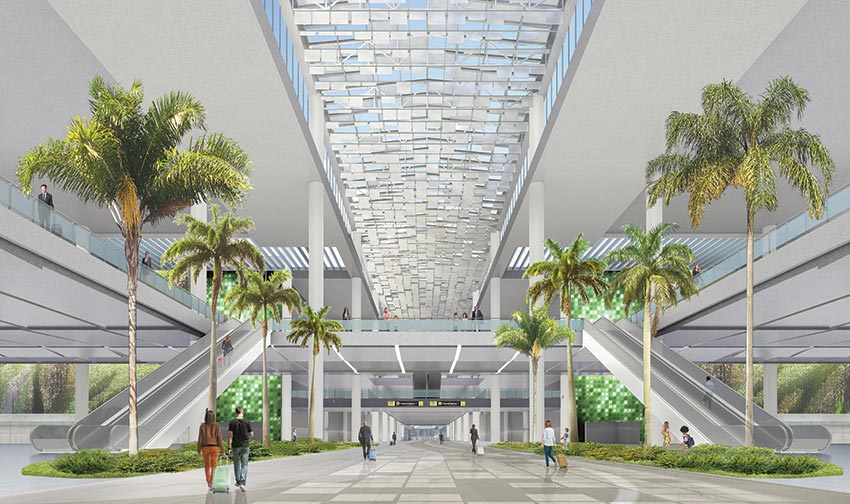
Images: Courtesy KPF (opposite, top and middle); grimshaw (opposite, bottom); HOK (Top); SOM (Middle); fentress (bottom)
Abu Dhabi International Airport Midfield Terminal
After 13 years, Abu Dhabi’s new government-funded terminal, by KPF, is slated to open in 2020. Considering that 80 percent of the airport’s visitors will be transfer passengers–it’s a midway point for many long-haul international flights–the terminal was designed to cater to travelers with lengthy layovers while promoting the city’s culture and its growing luxury sector. The 7.9 million-square-foot interior will include numerous amenities—the majority of which will be beyond security checkpoints—including a sculpture garden and a museum. The roofline, defined by rolling metal arches supported on steel beams, is meant to mirror the curves of desert sand dunes.
Heathrow International Airport Expansion
For the addition of a third runway to Heathrow, Grimshaw has designed a sweeping and swerving terminal to help accommodate the airport’s expected total of 130 million passengers a year. The undulating glass roof allows ample daylight for interior green spaces with a sustainable design for the London aviation complex. It is slated for completion in 2025.
Salt Lake City International Airport
Utah’s largest air hub will undergo an extensive expansion in the next five years. Salt Lake City International Airport’s terminal redevelopment program, led by HOK, will replace existing terminals with a three-story structure and 78 new gates, all of which are anticipated to be open by 2024. At the center of the terminal, large-scale interior sculptural walls, composed of rippling fins, enclose the shopping and dining areas. This architectonic element, called The Canyon, created by artist Gordon Huether, evokes Utah’s natural rock formations. HOK anticipates that its sustainable design, which includes high-performance glazing and energy-efficient mechanical and lighting systems, will achieve LEED Gold certification for the new SLC terminal.
Seattle-Tacoma International Airport International Arrivals Facility
For the upcoming Seattle-Tacoma facility, scheduled to open in 2020, SOM created eight new gates, increasing the total to 20. A bridge will allow international travelers to move on foot over taxiing aircraft. The new 450,000-square-foot building attempts to convey a strong sense of arrival, with windows on either side of the elevated passageway facing Mount Rainier on one side and the Olympic Mountains on the other. The roof, made of glass and aluminum panels, subtly follows the twists and turns of planes gliding through the air.
Orlando International Airport South Terminal Complex
Orlando’s forthcoming South Terminal Complex by Fentress is expected to add 19 gates capable of serving 24 planes by 2021. The firm designed a 2.7 million-square-foot international-terminal building with ticketing, security, customs, passport control, and baggage-claim areas arranged along a central 1,000-foot-long “boulevard” (above) linking the curbside of the terminal to the air side. Central civic spaces will punctuate the complex, with palm trees planted throughout the interior, illuminated by skylights.
Up, Up, and Away
When the TWA Terminal by Eero Saarinen opened at Idlewild airport (now JFK) in New York in 1962, it embodied the allure of air travel. Its open “wingspan” welcomed travelers into the glamorous interior, with its sweeping concrete curves. Despite the beauty of its structural expressionism, it proved not to be functional for the long term. As jets got larger and more travelers took to the air, the terminal became obsolete, finally closing in 2001. Fortunately, it now has been impeccably restored by Beyer Blinder Belle and suitably repurposed, as the centerpiece of the new TWA Hotel, by Lubrano Ciavarra. Two seven-story glass, crescent-shaped wings, accommodating 512 hotel rooms, embrace the indelible landmark. It’s a perfect place for a layover—or to lounge inside the sybaritic original space, sipping a martini and listening to Frank Sinatra.

Photography: Balthazar Korab/Library of Congress
